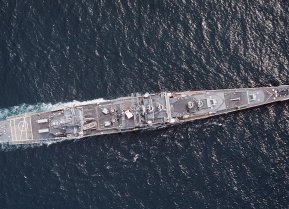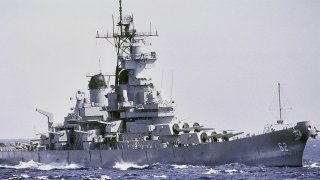Battleship Forgotten History: Iowa-Class Warship USS New Jersey Fought in Vietnam War
During the Vietnam War, the USS New Jersey, an Iowa-class battleship, played a significant role in naval gunfire support. As one of the largest battleships ever commissioned, its recommissioning in April 1968 marked a unique contribution to the conflict, offering devastating firepower from its nine 16-inch guns to support ground forces.
Summary: During the Vietnam War, the USS New Jersey, an Iowa-class battleship, played a significant role in naval gunfire support. As one of the largest battleships ever commissioned, its recommissioning in April 1968 marked a unique contribution to the conflict, offering devastating firepower from its nine 16-inch guns to support ground forces. Operating with little opposition from North Vietnamese naval capabilities, the New Jersey could target enemies up to 27 miles from the coast.
USS New Jersey's Pivotal Role in the Vietnam War: A Naval Powerhouse
Vietnam was mostly a ground war. American and South Vietnamese grunts fought it out against the North Vietnamese and Viet Cong in the jungles and rice paddies of South Vietnam.
There was also secret fighting in neighboring Laos and Cambodia, where American special operators led small teams against tens of thousands of Communist fighters in some of the most daring operations in American history.
However, air power and naval power played their own important roles. In providing naval support for ground fighting, the U.S. Navy used an unexpected warship: The USS New Jersey, an Iowa-class vessel and one of the largest battleships in history.
The Iowa-class Battleships in Vietnam
Out of the four Iowa-class battleships commissioned by the Navy, only one was still active when the Vietnam War started. The New Jersey, the second warship of the class, was recommissioned in April 1968 and completed a tour of duty in Vietnam, mainly in a naval gunfire support role. North Vietnam didn’t possess a significant naval capability, so U.S. warships could operate almost with impunity.
With nine 16-inch (406mm) Mark 7 guns in three turrets, the New Jersey could put out a devastating rate of fire to support U.S. and South Vietnamese forces close to the sea. Indeed, the battleship could hit anything that moved within 27 miles of the coast.
A year after its recommissioning and tour of duty, the Iowa-class battleship was decommissioned once again.
The Iowa was the Navy’s last and largest class of battleships. They came into service in 1943 with the USS Iowa.
The Navy had plans to build six Iowa-class warships but ended up ordering only four, and all four re-entered service at various points to help the Navy deal with pressing threats. Their last action was during the Gulf War against Iraq, in which they once more supported ground troops with naval fire. This time around, they were also equipped with Tomahawk land attack cruise missiles.
With a length close to 900 feet, draft of 37 feet, and displacement that could reach 57,000 tons with a full combat load, the Iowa-class battleships were large. But despite their size and weight, the battleships were very fast, capable of reaching speeds of approximately 33 nautical knots (38 miles per hour).
The USS New Jersey Today
The USS New Jersey is still around. It no longer serves, but rather acts as a floating museum in the Philadelphia Naval Shipyard.
The legendary battleship is currently undergoing a $10 million refurbishment. It will be getting new paint and coating, as well as repairs to its cathodic protection system. This is money well worth spending to preserve the history of a great warship from another age.

About the Author
Stavros Atlamazoglou is a seasoned defense and national security journalist specializing in special operations. A Hellenic Army veteran (national service with the 575th Marine Battalion and Army HQ), he holds a BA from the Johns Hopkins University, an MA from the Johns Hopkins’ School of Advanced International Studies (SAIS). He is pursuing a J.D. at Boston College Law School. His work has been featured in Business Insider, Sandboxx, and SOFREP.
All images are Creative Commons.


